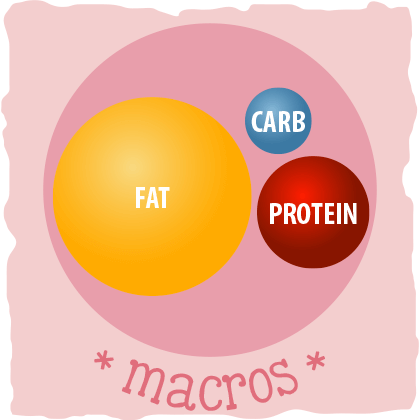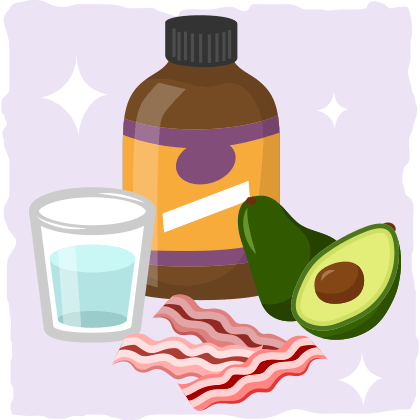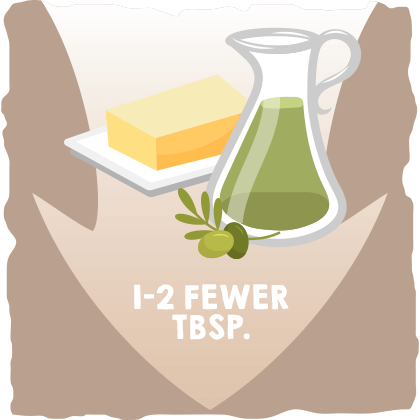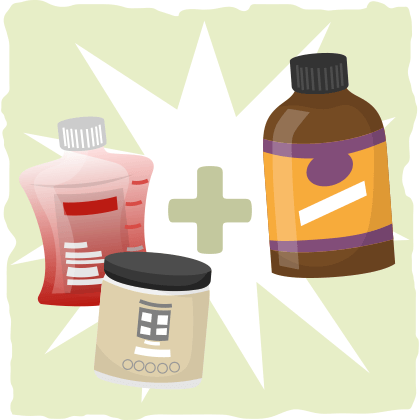With all the new people transitioning into a low carb diet and the increasing popularity of the standard ketogenic diet, we decided to put together a comprehensive keto FAQ on the questions that are often asked when someone is beginning their ketogenic lifestyle.
This is meant to be a quick reference guide with answers to the most common questions and concerns about going keto. If you have any other questions you’d like to be added, changed, or are unsure about – please feel free to leave a comment below so we can fully explain or make changes to the answers on this page.
Best wishes, and if you’re a new keto dieter reading this, good luck on your keto journey!
Top 30 Most Common Keto FAQs Answered
Click any of the questions below, and it will take you to the answer. If you don’t see your question below, check out our keto diet knowledge base for the answer. Most answers will be straightforward and concise, with a link to a more in-depth article(s) on the topic if you’d like to learn more.
- What Is A Standard Ketogenic Diet?
- What Does It Mean To Be Ketogenic?
- What is Nutritional Ketosis & How Does It Work?
- How Long Does It Take To Get Into Ketosis?
- How Do I Increase My Ketone Levels Naturally?
- How Can I Tell If I Am In Ketosis?
- Where Can I Find Low Carb And Keto-Friendly Recipes?
- How Should I Track My Carb Intake?
- Do I Need To Count Calories?
- Can I Eat Too Much Fat?
- How Much Weight Will I Lose?
- What About Heart Attacks From All This Fat?
- What Are Macros And Should I Count Them?
- Should I Limit Protein Intake On Keto?
- What Foods Can I Eat?
- Do You Have A Sample Menu I Can Look At?
- Is There A Free Keto Diet Plan I Can Try?
- Can I Do Keto If I Don’t Eat Dairy?
- Can I Do Keto If I’m A Vegetarian/Vegan?
- Can I Intermittent Fast With Keto?
- I Just Started And Feel Like Crap. What Should I Do?
- I Have Constipation After Starting Keto, What Do I Do?
- Can I Drink Alcohol On This Diet?
- I Stopped Losing Weight. What Can I Do?
- I Am Gaining Weight. What Should I Do?
- Can Athletes, Weightlifters, and Weekend Warriors Follow Keto?
- Can Keto Help With Elevated Blood Sugar Levels?
- What Supplements Should I Take to Boost Keto Results?
- Should I Take Exogenous Ketones And/Or MCT Oil?
- Can I Use Sweeteners Or Sugar Alcohols On Keto?
- Common Keto Terms and What They Mean
What is a Standard Ketogenic Diet?
The keto diet can be described in many different ways, but the simplest way I’ve found to conceptualize a ketogenic diet is this:
If you restrict carbs to the point that you enter and sustain ketosis, you are on keto.
Typically, this requires us to be on a high-fat, very low-carb, low-to-moderate protein diet.
What Does it Mean to be Keto or Ketogenic?
A diet that is keto (the short-hand term for “ketogenic”) is one that stimulates the production of ketones in the liver via a process called ketogenesis. Limiting carb intake is the healthiest way to promote sustained ketone production.
When carbs are restricted for a long enough time (i.e., 2-7 days), we eventually enter a metabolic state called nutritional ketosis.
What is Nutritional Ketosis? How Does Ketosis Work?
Ketosis is a metabolic state in which your body consistently uses and burns a highly efficient alternative fuel called ketones. The healthiest way to do this is by limiting carb consumption low enough that it forces your body to burn fat and ketones as its primary fuel source instead of sugar.
You can find our in-depth article about Ketones, Ketosis, and How It All Works if you’re interested in the science behind it all.
How Long Does It Take To Get Into Ketosis?
It takes time for your body to adjust and enter into ketosis. This process can take anywhere from 2 – 7 days, depending on your body type, activity levels, what you’re eating, your current health status, and your previous diet.
The fastest way to get into ketosis is to start your morning off with a caffeinated beverage + a ketogenic MCT oil, exercise on an empty stomach, and restrict your carbohydrate intake to 20g or less per day.
To accelerate the rate at which you enter ketosis, there is a method called the Fat Fasting Technique. We’ve written an article on Fat Fasting on a Ketogenic Diet and everything involved with it. Make sure you only use this method for a few days (otherwise, it can lead to nutritional deficiencies).

How Do I Increase My Ketone Levels Naturally?
The best way to increase ketone levels is with a ketogenic diet. Typically, this will require you to limit your daily carbohydrate intake to 35 grams of total carbs and 25 grams of net carbs. (Net carbs are found by subtracting the grams of the fiber from the total grams of carbs.)
As mentioned in the previous question, you can restrict carb intake below 20g to increase ketone levels more quickly.
To boost your ketone levels even further, you can also try:
- Supplementing with MCT Oil.
- Drinking a caffeinated beverage in the morning (caffeine increases ketone production).
- Intermittent fasting.
- Implementing the fat fasting technique.
- Adding exercise to your daily routine (fasted exercise can help boost ketone levels even more).
How Can I Tell If I Am In Ketosis?
Though there are signs of ketosis you can look out for, the most accessible way to find out is using Ketostix. They can be picked up online or at your local pharmacy.
Keep in mind, however, that Ketostix measure the amount of acetone in your urine, which are unused ketones. The primary ketone that is used by your body and brain for energy is called Beta-hydroxybutyrate (BHB) and is not measured by Ketostix.
The most reliable and accurate way to measure your ketone levels is by using a blood ketone meter. This will directly measure how much BHB is in your blood.
For more info on checking ketone levels, check out our in-depth article on measuring ketosis.
Where Can I Find Low Carb and Keto-friendly Recipes?
A quick Google search for a particular keto or low carb recipe will yield you hundreds of results. Nowadays, you will be able to find a keto-friendly version of almost any high-carb favorite. For example, french fries, pizza, lasagna, pasta, cookies, cakes, cereal, and even ice cream can be made keto (click the links to find out how).
Ruled.me has hundreds of recipes you can check out, ranging from breakfast to dinner and even dessert. Check out our Keto Recipes section to get inspired in the kitchen!
How Should I Track My Carb Intake?
The most common way to track carbohydrate intake is by using MyFitnessPal, Cronometer, or the Carb Manager app. We created a comprehensive guide to monitoring carbs using each app which you can find by clicking this link.
Do I Need To Count Calories?
Calories matter, but this doesn’t mean you must count them to lose weight.
With a ketogenic diet, for example, you rarely have to worry about calorie intake because keto foods tend to fill us up and keep us fuller longer than heavily-processed carb-laden foods.
That being said, it is still possible to eat too little or too many calories on keto.
If you’re not getting the results you expect, or if your wellbeing has decreased substantially, then you may need to track calories for a few weeks to get a better idea of how much you should be eating at each meal.

Can I Eat Too Much Fat?
In short, yes, you can eat too much fat.
By eating an excessive amount of dietary fat, you will burn through fat you just ate rather than your stored body fat. This will result in slowed weight loss, weight loss stalls, and in some cases, weight gain.
To help you recalibrate your fat intake needs, use our keto calculator. This simple tool will help estimate your macros and determine how much fats, proteins, and carbs you should be eating each day.
Keep in mind when you fill this out, you can edit the values of your protein and carbs (and should do so, depending on your activity levels). If you have any questions on this, please let us know in the comments.
How Much Weight Will I Lose on Keto?
During the first week of the keto diet, people typically see rapid weight loss — anywhere from 2 to 10 pounds. Though this is unrivaled by any other diet, most of this weight is from shedding body fluid rather than body fat.
Once you’ve made it through the first week of keto and you’re in ketosis, fat will steadily fall off your body (as long as you are in a calorie deficit). The average weight loss at this point is around 1-2 pounds per week — the majority of it coming from fat.
That said, the amount of weight you lose is totally dependent on you, your body, and your keto lifestyle. By adding exercise to your regimen, for example, you can help speed up your fat loss and preserve muscle mass along the way.
If you’d like to learn more about weight loss results on keto, check out our guide to losing weight.
What About High Cholesterol and Heart Attacks From All This Fat?
The current literature indicates that the keto diet typically has the following effects on blood lipids:
- Increases HDL cholesterol levels.
- Increases LDL cholesterol levels, primarily by increasing LDL particle size. This may be optimal because larger LDL particles are less harmful than smaller varieties.
- Decreases triglyceride levels.
Furthermore, keto eating can improve several other risk factors for heart disease, including high blood pressure, type 2 diabetes, and abdominal obesity.
In general, there is plenty of high-quality data supporting that the keto diet can improve blood lipids and reduce the risk of heart disease for most people. This is particularly true if most of your fat intake is coming from minimally-processed sources of polyunsaturated, monounsaturated, and saturated fats.
The only universally bad fats you should avoid are artificial trans fats, partially/fully hydrogenated oils, and refined oils that are high in omega-6 fatty acids.
That being said, there are a few subsets of the population that can experience a worsening of blood lipid levels after following a high fat, low carb diet. This is why it is crucial to monitor your health when making any major dietary change.
For an in-depth breakdown of the research and practical strategies for optimizing your blood lipids and heart health, please read through these articles:
- The Ketogenic Diet and Cholesterol
- What Is the Best Triglyceride Lowering Diet?
- The Ketogenic Diet and Heart Disease
What Are Macros and Should I Count Them?
“Macros” is the abbreviated term for “macronutrients.” The “big 3” macronutrients are fats, proteins, and carbohydrates. Almost all of our energy comes from these macros, which is why they contribute calories to our diet.
Other than monitoring carbs for ketosis, this is another reason why some keto dieters track their macros. You’d be surprised how easy it is to underestimate how much fat and carbs we get from the food we eat.
Counting your keto macros is also helpful if you come to a stall in your weight loss results.
In fact, it is one of the most effective strategies for recalibrating your keto meals and getting back on track toward your weight loss goals.

Keep in mind that you have some wiggle room with your macros. In most cases, as long as you’re within 10-15 g of your intake goals for fat and protein, you’ll stay on track!
You can find a more in-depth article on macronutrients and why they are important to us by clicking here.
Should I Limit Protein Intake For Ketosis?
Although overeating protein can indeed decrease your ketone levels, it is difficult to reach this point without trying. In general, as long as you stay within these ranges (and keep your carbs below 35 grams), you should have no problem entering and staying in ketosis:
- If you are sedentary — consume 0.6 – 0.8g of protein per pound of lean body mass.
- If you are regularly active — have 0.8 – 1.0g of protein per pound of lean body mass.
- If you lift weights — eat 1.0 – 1.2g of protein per pound of lean body mass.
For those of you who want more precise protein intake recommendations, the best resource is our keto calculator. From there, feel free to experiment with higher protein intakes while measuring your blood ketone levels if you’d like to find your personal protein limit for ketosis.
What Foods Can I Eat?
This is arguably the most common keto FAQ. The main thing is to stay away from high-carb foods, including sugars, baked goods, flour, pasta, rice, potatoes, grains, and sugar-sweetened drinks.
It might sound so simple when you look at it that way, but you’d be surprised at how common carbs are in our favorite foods. Potato chips, tomato sauce, and even salad dressings can have excessive amounts of carbs in them.
Most of your keto meals will consist of fresh cuts of meat/seafood and non-starchy veggies with additional cheese, fats/oils, and herbs/seasonings.
Click this link to be brought to a comprehensive keto food list to get you started on building a shopping list and meal plan. You can also find our keto food pyramid by clicking here.
Once you develop a better idea of high-carb vs. keto-approved foods, I recommend learning more about clean keto foods and the lazy, dirty keto approach to help you create a balanced keto lifestyle that fits your schedule and food preferences. For more info on clean keto foods and dirty lazy keto convenience options, check out our clean vs. dirty guide.
Do You Have a Sample Menu I Can Look At?
To access all the recipes on a keto menu, check out our recipe catalog.
Or, if you’re looking for keto-friendly options for a specific meal, click the relevant link below:
Keep in mind that the amount of calories, fats, proteins, and carbs change per person. Use our keto calculator and split your macros among your favorite keto recipes to figure out what your personal meal plan may look like.
Is There A Free Keto Diet Plan I Can Try?
If you’re looking for a way to experiment with keto, we’ve put together a 14 Day Keto Diet Plan with a shopping list and budget breakdown. This will help you get a better idea of what an average keto dieter will eat regularly and how it all plays into calculating your macros.
The key with keto meal plans like this is to make it fit into your own macros. That means adjusting the portion sizes to make the calories higher or lower.
You may need to adjust fat content (taking away cheese or fats/oils, adding cheese or fats/oils), change protein content to meet your needs, and adjust the carb count if necessary.

Can I Do Keto If I Don’t Eat Dairy?
Though cheese, butter, and cream are everyday staples, it is surprisingly easy to go keto without dairy products.
Get your fats from coconut, olive, and avocado products, low-carb nuts and nut butters, fresh cuts of meat, and fatty fish. Cook with extra virgin olive oil and refined coconut oil, and try using coconut cream as a substitute for heavy cream. (There are plenty of plant-based keto-friendly cheeses you can try as well.)
For a complete guide on dairy-free keto, click this link.
Can I Do Keto If I’m A Vegetarian/Vegan?
Going vegetarian or plant-based with a keto diet is possible, but it will require a bit more planning and mindful food selection. Since a standard ketogenic diet typically emphasizes meat, dairy, and seafood as primary fat and protein sources, it is crucial to make sure you are getting enough protein and nutrition without excess carbs.
Here is a link to our vegetarian keto guide for a comprehensive outline of how to make it work for you.
Vegan keto dieting will require another step up in mindful food choices and meal planning to pull off successfully. For a comprehensive guide on how to implement a ketogenic vegan diet, click this link.
Can I Use Intermittent Fasting on Keto?
Yes, intermittent fasting and keto diets work wonderfully together!
Not only will intermittent fasting help boost your ketone levels, but the keto diet will help you fast for longer without feeling hungry and tired.
For a complete guide on how to integrate these two dietary approaches, check out our keto intermittent fasting article.
I Just Started to Feel Like Crap. Is This the Keto Flu & What Should I Do?
Keto beginners often experience flu-like symptoms such as headaches, fatigue, and “brain fogginess” as their body is adapting to carb restriction and ketosis. This is typically the result of rapid water and electrolyte excretion.
You can usually remedy this by staying hydrated and eating plenty of electrolytes (i.e., broth, salty foods like bacon and deli meat, salted nuts, avocado, and keto chocolate). These are good things to consume while you’re transitioning into ketosis to help you feel and function better.
MCT oil and keto electrolyte supplements are some other proven remedies that can help with the keto adaptation process. You can find a comprehensive article on keto flu, its symptoms, and cures by clicking this link.

What Can I Do If I Am Constipated?
It’s fairly common for people starting out on keto to have irregular bowel movements. Below is a list of common advice given to people for constipation or bowel movement problems:
- Drink plenty of water with electrolytes
- Eat more low-carb vegetables, nuts, and seeds
- Try coffee or tea
- Take a magnesium supplement
- Take a psyllium husk fiber supplement
Can I Drink Alcohol On This Diet?
Alcohol can be consumed while on keto, but you must be cautious. Most alcoholic beverages are packed with enough sugar and calories to impair your keto results.
The main takeaway here is to stick with unflavored hard liquor. Wine, beer, and cocktails all have carbohydrates in them. Clear liquor is your best bet, but make sure you are steering clear of flavored liquors, as they have added sugars in them.
For specific alcohol drink recommendations and tips, check out our guide to keto and alcohol.
I Stopped Losing Weight. What Can I Do?
Weight loss plateaus are more common than you might think. There are several methods that may help you out – ranging from cutting certain foods out of your diet to changing your eating patterns through intermittent fasting or fat fasting.
Here’s a list of common suggestions that are normally advised to people that aren’t losing weight:
- Recalculate and track your macros for a few weeks to recalibrate your diet
- Cut out some dairy
- Reduce how much fat/oil you add to meals
- Decrease your carb intake
- Stop eating nuts
- Stop eating gluten
- Cut out artificial sweeteners
- Look for hidden carbs
- Begin cutting processed food from the diet
- Switch to measuring instead of weighing
- Start your morning with coffee and ketogenic MCTs followed by exercise
To learn more, read through our in-depth article on weight loss plateaus and how to break through them.
I Am Gaining Weight On Keto. What Should I Do?
If you’re experiencing unexpected weight gain, these tend to be the most common triggers:
- Adding too much fat/oil to meals
- Not eating enough micronutrient-rich foods
- Snacking on high-fat snacks without being mindful of portion sizes
- Overeating on cheat day(s)
- Drinking too much alcohol
- Neglecting the importance of stress relief and sleep quality
- Being less physically active than usual
- Eating too many carbs
Start with the easiest option for your lifestyle and build off of that momentum.

For example, sometimes all it takes is using 1-2 fewer tablespoons of butter or oil in your meals to encourage fat loss again.
To learn about the causes of and solutions for unexpected increases in weight (as well as hunger) on keto, click this link.
Can Athletes, Weightlifters, And Runners Follow Keto?
If you’re someone who does a lot of cardio – endurance running, biking, marathons, or the like — then you don’t need to worry. Studies show that aerobic training (endurance training) isn’t affected by low carbohydrate diets. (Here’s a more in-depth article on training on a ketogenic diet.)
However, if you’re training at high-intensities, such as heavy weightlifting, sprinting, and high-intensity interval training, carbohydrates will help your performance and workout recovery. That means faster gains and better strength and power performance in your training sessions. If you’d like to incorporate carbs into your diet for high-intensity performance, there are two main approaches: TKD and CKD.
- TKD is a targeted ketogenic diet, where you strategically target carb intake before your workout. This will supply your muscles with the quick-burning glucose they need to support high-intensity activity. Once it is used up after you finish your workout, your body will ramp up ketone production again. You can read more on the targeted ketogenic diet by clicking this link.
- CKD is a cyclical ketogenic diet. This is more for bodybuilding and competitors that want to stay on a ketogenic diet while still building muscle with high-intensity workouts. It is also used to shed or increase water weight as needed for weigh-ins and aesthetics. In this method, you stay on a regular ketogenic diet for a period of time (usually 5 days) and then do what is known as a carb-up (usually two days or the weekend). In a CKD, you are essentially replenishing all of your glycogen stores for your high-intensity training sessions during the week. You can read more on a cyclical ketogenic diet in the article I wrote.
For everything you need to know about exercising on the ketogenic diet in one place, check out our comprehensive guide on the subject.
What Will Keto Do To My Blood Sugar Levels?
Limiting carbohydrate intake typically results in a subsequent decrease in blood glucose levels. This is why diets that limit total carbs are often recommended for managing type 2 diabetes and can be used as a strategy to reduce insulin requirements in type 1 diabetes.
In fact, some research suggests that the keto diet effectively manages and, in some cases, reverses type 2 diabetes.
What Supplements Should I Take?
Sometimes we can get cramps or just not feel “right” after starting a ketogenic diet. Some supplements that are commonly suggested for keto dieters include:
- Multivitamin for Women
- Multivitamin for Men
- Magnesium Supplement
- Vitamin B Complex
- Vitamin D Supplement
- Potassium Supplement
Always check with your doctor before introducing vitamins into your diet.
For an in-depth look at the best supplements for your keto lifestyle, check out our keto supplements guide.
Should I Take Exogenous Ketones And/Or MCT Oil?
You’ll come across many keto diet supplements that claim to boost ketosis and fat loss, such as keto pills, exogenous ketone salt powders, and MCT oil.
Exogenous ketones and keto pills will boost ketosis, but they will also impair your natural ability to produce ketones in the process. This is why we recommend supplementing your diet with ketogenic medium chain triglycerides (MCTs) if you want to boost nutritional ketosis and energy levels.
Ketogenic MCTs are a type of saturated fat that can be directly absorbed into the liver and converted to ketones. To put it more succinctly: Ingesting ketogenic MCTs will help enhance ketone production and support your body’s ability to enter and maintain nutritional ketosis, while keto pills and exogenous ketones will not.

For a closer look at ketones and ketone-boosting supplements, check out our comprehensive article on ketones.
Can I Eat Sugar-Free Sweeteners And Sugar Alcohols On Keto?
Yes, but not all “sugar-free” sweeteners and sugar alcohols will have the same impact on our bodies. There are a bunch of low-calorie sweeteners and sugar alcohols on the market now that will contribute more net carbs to our diet than they claim on the label.
For this reason, we recommend sticking with pure erythritol, monk fruit extract, and stevia (or a blend of these natural keto sweeteners) because they typically don’t cause blood sugar or insulin spikes. When used in combination, they seem to cancel out the aftertaste that each has and sweeten just perfectly.
For a comprehensive look at all of the best and worst sweeteners for keto, click here. In this article, we break down every popular sweetener along with its carb content and glycemic index to give you a better idea of what you should use and what you should avoid.
Common Keto Diet Terms and What They Mean
- AS: This means Artificial Sweetener, which is a category of sweetener that doesn’t exist naturally and is used to sweeten our foods with a reduced or zero carb count.
- BHB: Beta-hydroxybutyrate. The primary ketone that our body uses for energy. The main ingredient of exogenous ketones (which are not needed).
- BPC: This is known as Bulletproof coffee. We adapted the recipe to make it more ketogenic with our Ketoproof Coffee recipe. Essentially, you’ll be blending grass-fed butter, MCT oil, and coffee with an emulsion blender to help up your fat content, boost ketone levels, and give you a “full” feeling through the morning.
- CICO: Calories in, calories out. The basic idea is that energy stored = energy in – energy out.
- CKD: Cyclical ketogenic diet. Alternating between a standard keto diet and a higher carb diet to help aid high-intensity exercise performance.
- Fat Bomb: These are generally packed full of oils and fats to up our fat content for the day. Some people have trouble keeping up with their fat content, so they make a fat bomb to help them out. Here is a delicious fat bomb recipe for you to try. You can find more recipes and DIY options in our keto fat bomb guide.
- Gluconeogenesis: the biochemical process of breaking down amino acids into glucose. Click here if you’d like to learn more about this process.
- Glycolysis: the biochemical process of breaking down glucose into energy.
- HWC: This stands for Heavy Whipping Cream. Just ordinary cream that, for a lot of us, is a daily staple in our coffee and keto diet.
- IBS: Irritable bowel syndrome. Depending on the person, keto can either improve IBS symptoms or aggravate them.
- IF: The abbreviation for intermittent fasting. This is a diet approach that can be used to increase fat loss and ketosis. There are many IF approaches; the most common is being a 16-hour fasting window followed by an 8-hour feeding window. Learn more by checking out our complete guide to IF on keto.
- IR: This relates to insulin resistance. This is when the body’s cells cannot properly respond to the insulin hormone.
- Keto: Ketogenic. A shorthand term that many people use.
- Ketoacidosis: a metabolic state where an unusually high concentration of ketone bodies leads to acidic blood levels (which can be lethal). This typically only happens in diabetics.
- LCHF: Low Carb High Fat. This is the most sustainable approach for nutritional ketosis.
- MCT: Medium Chain Triglyceride. These can help boost your metabolism and are quite unique. When they are metabolized, they can be turned into ketones straight away. The best MCTs for boosting ketone production are caprylic acid (C8) and capric acid (C10).
- Micro: Micronutrients. The vitamins and minerals that are in our foods.
- Net Carb: The carbs in food that can negatively impact ketosis. To find the net carb content of any food item, you will subtract the number of grams of “Dietary Fiber” from the number of grams of “Total Carbohydrate.”
- NSV: Non-scale victory.
- RDV: Recommended daily value.
- SAD: Standard American Diet. The typical diet of most Americans.
- SF: This means Sugar-Free. There are a range of sugar free foods that a lot of people consume, normally containing artificial sweeteners.
- TKD: Targeted ketogenic diet. Intaking carbs prior to a workout. Usually used with moderate-high intensity workouts when a standard ketogenic diet is not giving enough energy to get through them.
- WOE: Way of Eating. This is just a term used to reference someone’s diet.
Terms Related Fat and Fat Intake
Triglycerides: 3 fatty acids attached to a glycerol backbone.
Fatty acids: the fats that we digest from the foods we eat. The three main fats we get from foods are:
- MUFA – Monounsaturated fatty acid.
- SFA — Saturated fatty acid.
- PUFA – Polyunsaturated fatty acid. The two types of polyunsaturated fats are omega-3 and omega-6 fatty acids.
Omega-3 – Omega 3 Fatty Acid. There are three types:
- EPA – Eicosapentaenoic acid.
- DHA – Docosahexaenoic acid.
- ALA – Alpha-linolenic acid. Only available in nuts and seeds.
Omega-6 – Omega 6 Fatty Acid. Here are the most common types:
- GLA – Gamma-linolenic acid.
- CLA – Conjugated linoleic acid.
- LA – Linoleic acid.
- ARA – Arachidonic acid.
If we didn’t answer one of your keto questions, search our keto diet knowledge base for the answer or leave a comment below.